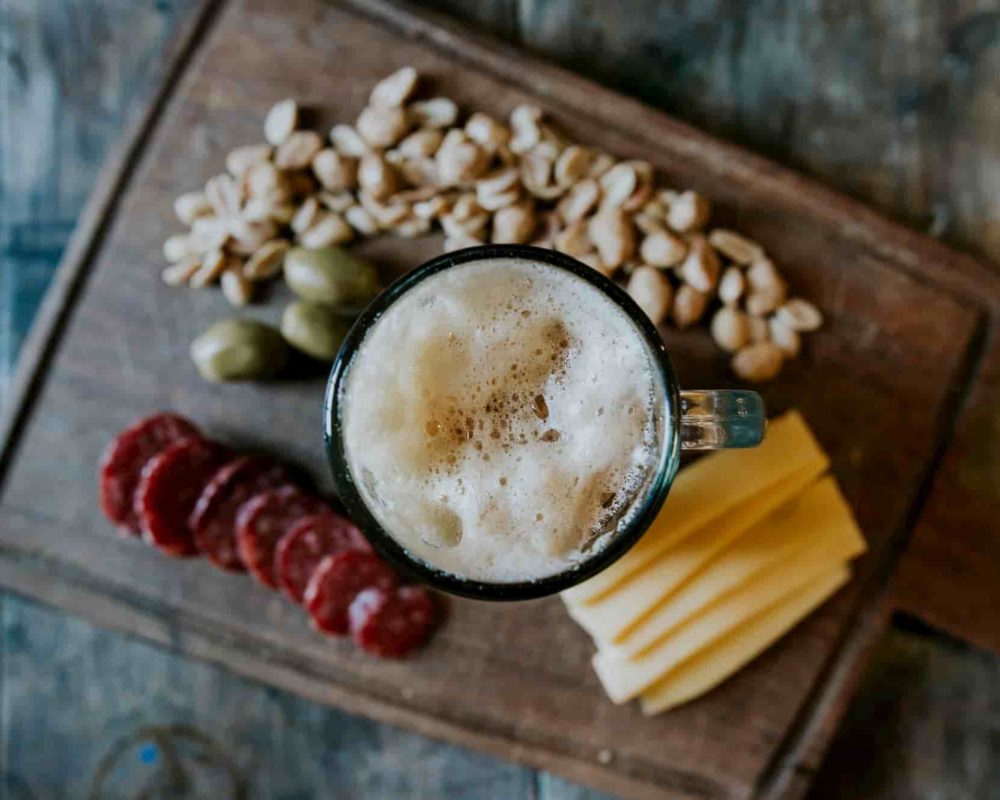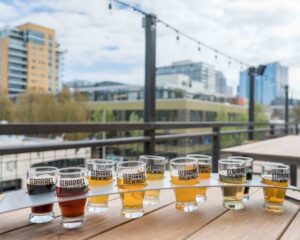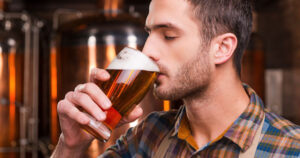It’s fun to experiment: if you put five cheeses on a board and have three beers.
A fun suggestion is to try three different beers and five different cheeses. Then you can go through each of them while thinking “how is this with this?” or “how is this with that?”
There’s many different styles of beers out there, just like there are types of cheeses.
The following suggestions are for different flavors that you can add to differentiate and highlight the beers. Great for a date night, or just having fun learning about the complex world of craft beer. The beer geek in me has had a lot of fun writing this. I hope you enjoy!
I always advocate going into your beer pairing with an open mind and expect to have a good time, (because it’s going to be.)
____
When I think about food pairings in general, the blanket statement is to remember “The Three C’s”, which are Cut, Compliment and Contrast.
That goes with any beverage when pairing with food. You either want to “cut” through the flavorit with the alcohol, “compliment” the food or “contrast” it thoughtfully.
I recommend starting light and working your way progressively darker. The heavier the beer, the more flavor it will leave in your mouth and may taint the rest of the experience. In the beginning, start light with either a cold lager or a pilsner, or a Belgian blonde, or a wit beer. Work your way through the ales, and end with a stout or a porter.
What does a Pilsner or Lager pair with?
Pair a pilsner with light foods like salads and cheeses.
When a Cicerone describes a pilsner, they’ll tell you to notice the Pilsner’s light, grassy and malty qualities. As such, when pairing a cheese with a pilsner, you’ll want to go with a cheese that’s going to do one of those Three C’s to interact with it.
Something fatty that would “cut” through the highly carbonated and light-tasting Pilsner would be like a nice creamy brie cheese, for example.
Or you might go with a salty, not overly fatty manchego cheese to “compliment” your pilsner.
Recommendation: Pair a German Helles Lager or a Belgian Saison with a Honey Goat Cheese
Game changer: Try to get your hands on a light German Helles lager (pronounced “hell-iss), because there’s a lot of honey profile to that beer without it being overly sweet. Complement that natural sweetness with a honey goat cheese and you’re bound to impress anyone with a mouth. I challenge you to tell me this is not heaven on Earth.
Saisons, the Belgian style of beer, pretty much pair with everything because they’re highly carbonated and yeasty enough to cut through sweetness and fat. Get one of these for your beer pairing and tasting event, and you’re sure to notice how well it pairs with things. I recommend starting with the Saison Dupont.
What does a Wheat Beer pair with?
If you can get it, Allagash white is a really great light beer that would work for this pairing. A beer like Allagash would greatly benefit from something fatty to cut through it.
Something salty would pair nicely with a wheat beer to give it a nice complimentary flavor. Try a Brie with a wheat beer like Allagash White. While you’re at it, pick up some manchego to eat alongside your brie to see the contrast and difference of cutting through the fat of each cheese.
The higher the carbonation of your light beer, the more noticeable it will be.
What pairs with Brown Ales, Amber Ales, and Red Ales?
Oftentimes these days Brown Ales, Amber ales, and Red Ales get overlooked.
They’re not as popular right now as IPA’s and more hoppy beers, but anything that’s malt forward like a Brown or a Red ale go excellently with an aged cheddar or a Gouda. Try them with something a little nutty, a little sharp.
A Tillamook cheddar with a brown ale goes great. Or try something with a little bit of musk to it, like a nutty, hard Gouda or an English coastal cheddar would go great with a Brown ale, Amber Ale, or Red Ale.
Tasting Pairings With IPA’s and Pale Ales
IPA’s and Pale Ales are tricky to pair with because they’re so hop forward and hops don’t have a ton of pair matchings in general. One exception is that a hoppy beer, as a general rule goes great with spice. Try an IPA with a spicy curry sometime.
Or if you wanted to pair an IPA with a cheese, try to find something with jalapeno or habanero in it. That will pair excellently with your hop-forward IPA’s and Pale Ales.
What does a Porter pair with?
Porters are oftentimes going to be more coffee-flavored but also lighter bodied. A porter might go better with a pecan pie. You’re still going to get those like dark maple, nutty flavors.
What does a Stout pair with?

Pair Stouts with dark fudgy chocolate, dark chocolate truffles or roasted meats – like a pork or pot roast.
Stouts with Blue Cheese
A solidly impressive pairing is to remember the rule, “go funky and dark.”
Heavy, rich stouts go surprisingly well with blue cheese because there’s the richness and dark chocolate tones of the stout, (and maybe even some dark fruit notes) that are going to completely cut through the funkiness of a Gorgonzola or a blue cheese for a wildly enjoyable experience.
Talking Points. Expand your beer knowledge.
What is the difference between a Lager and an Ale?
But your categorization all comes down to the type of yeast used – either ale yeast, or lager yeast.
It all “boils down” to the methods used for brewing which are clinical scientific definitions.
Lagers ferment at a different temperature and method than an ale. Lagers are a bottom-fermenting beer, and ales are a top-fermenting beer.
That means that when they’re fermenting, the yeast is going to ferment at different points of the fermentation vessel.
This means that the yeast is going to eat away at the sugars that the malt produces in a different method & temperature.
What is an Ale?
Ales are the most common & fastest types of beers to brew. Ales are a top fermenting beer which ferment at about anywhere around 50 to 60 degrees Fahrenheit, and they ferment much quicker because of the heat.
But the temperature of fermenting the yeast means that it is going to eat up the sugars quicker than a lager would.
What is a Lager?
Lagers, on the other hand are bottom fermenting beers, where yeast come into the tanks. The lager yeast sits at the bottom of the tank which is where they eat those sugars away.
They ferment at much colder temperature, 45 to about 55 degrees Fahrenheit. And they take much longer to ferment – anywhere from about 8 to 12 days versus 4 to 6 days for an ale.
How would you describe the taste difference between a Lager and an Ale?
Lagers are often beers that are crisper and cleaner. A pilsner, for example, is a style of lager. Like you have red wines and the different varietals of red wine – a Pilsner and a Helles are simply different types of lagers. This is the same kind of thing where an IPA (India Pale Ale) is a style of…you guessed it – an ale. Pale Ales, Stouts and Porters are all also Ales.
Like you’ve got two umbrella categories of wine, red wine or white wine – remember, you’ve got the same for beer in Ales and Lagers
Stout is a type of ale. And there are “twists and turns” within their umbrella. You can have a certain type of Porter of Baltic Porter – which is actually a lager because it’s a Porter brewed with lager yeast (complicated, I know).
Remember that color does not always equal style. You can have dark ales, you can have dark lagers, you can have light lagers, you can have light ales. It really depends on the kind of prominent features of the beer.
The four main ingredients being water, malt, hops, and yeast. Water is the most prominent feature in all beer.
I like to think of beers as either malt, hop, or yeast-forward to describe how predominant features affect the taste and smell of each beer.
A Pilsner is kind of a classic example. It’s a hot summer day beer. It’s going to be effervescent, carbonated and bubbly. It’s going to have a refreshing taste almost like a grassy straw or light, graham cracker notes within it.
There’s also a Helles lager, which is a German style lager. These are oftentimes beers that have honey & Graham Cracker notes. Lagers are typically malt forward but can sometimes be hop forward, too.
Porters vs Stouts
So, Stouts and Porters are two different types of ales, but it all comes down to the barley that’s in those beers.
Malt, or malted barley, is one of the predominant features of beer. The only difference is that a stout has roasted barley and the porter’s barley is not roasted.
Note: The Brewers Association has a list of all beer styles & their definitive categories; For instance, a Porter should be between a certain alcohol beverage content, or ABV, have a certain color spectrum, and a few other ways to identify what a porter is.
These Style Guidelines, known as the BJCP or “Beer Judge Certification Program”, outline quantitative and qualitative measurements that define each and every beer style, along with any variants of a beer style. For example, with Stouts, there are Imperial Stouts, Irish Stouts, Sweet Stouts, and more varieties that fall under Stout beer, each with their own set of data to define what makes them that type.




